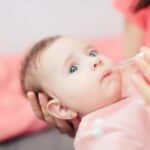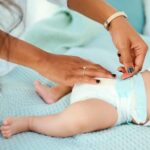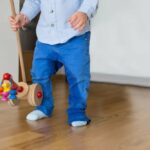There is nothing more relaxing than a day at the beach. Watching the waves of the ocean gently wash along the shore while cradling your newborn baby is pure heaven.
The serene environment can instantly provide a feeling of calm over your little one that nothing else can compare to. The gentle breeze as the sun begins to set is the perfect temperature.
There are no set rules for when it is safe for a newborn at the beach. Instead, make sure that you are aware of safety precautions to take and have the right baby gear. Then, you can head to the sand whenever you would like!
Is It Safe To Take Newborns To The Beach
Yes! Newborns will enjoy the beach as much as the rest of us will. However, being that they are newborns, you’ll need to take precautions to make sure that your little one has a positive experience.
As long as you take proper safety precautions against common dangers, such as heat, sunburn, and drowning, you can enjoy a safe day at the beach.
When Can I Take My Baby To The Beach?
You can take your baby to the beach whenever you’re ready. It’s important to remember that newborns and younger infants might not enjoy the experience as much as older children will.
However, that doesn’t mean that you can’t take your infant along on the family vacation. Instead, take your little one with you when you go to enjoy the moment together!
Taking An Infant To The Beach
View in gallery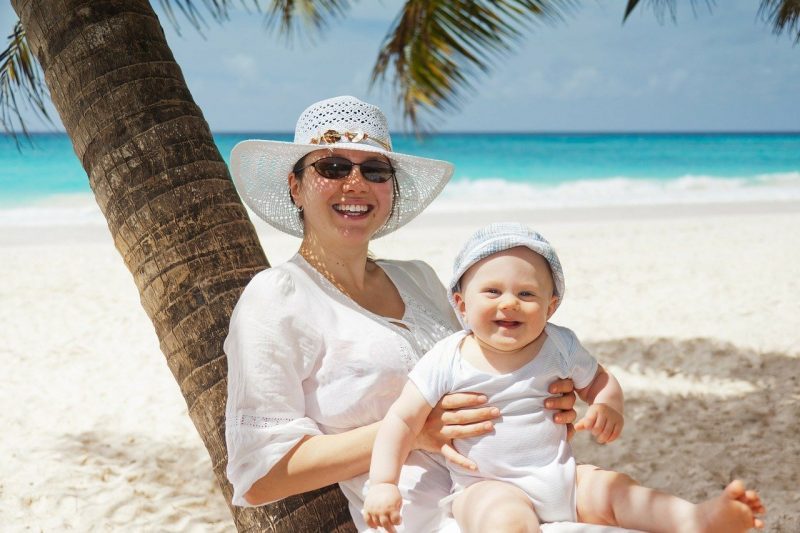
Taking a newborn to the beach is perfectly safe, but there are quite a few things to keep in mind. Safety, including water safety, should be considered when planning your trip.
It’s also important that you know what to pack, know what other dangers to look out for, and to make sure that your baby has everything that they will need so that they are safe, and you don’t have to cut your day at the beach short.
Water Safety
When most parents think of water safety, they imagine a toddler walking to the water’s edge. However, water safety is also important for newborns.
Waves from the ocean can be unpredictable, especially for those that are new to the beach. They might wash further onshore than you would expect, which could lead to your baby being submerged in the saltwater.
Make sure to pick a spot that is away from the water’s edge to protect your baby.
Older children should be held or in an enclosed area, such as a playpen or a sun tent to make sure that they do not crawl into the water.
As an additional safety precaution, many parents choose to pick up a set of floaties for their children just in case they wander away. The ocean is, after all, extremely captivating.
[amalinkspro type=”showcase” asin=”B00HN98OLI” apilink=”https://www.amazon.com/dp/B00HN98OLI?tag=mominformedcom-20&linkCode=osi&th=1&psc=1″ new-window=”true” addtocart=”false” nofollow=”true” sc-id=”4″ imgs=”LargeImage” link-imgs=”false” specs=”Meet strict requirements for use on boats, in public pools, and at water parks that require Coast Guard-approved devices~~~Nylon shell for durability~~~Playful designs make water safety fun for kids~~~Give beginners confidence when learning how to swim~~~Designed to fit snugly for added safety~~~” btn-color=”#ff9900″ btn-text=”Buy on Amazon” alignment=”alignnone” hide-prime=”0″ hide-image=”0″ hide-reviews=”0″ hide-price=”0″ hide-button=”0″ width=”750″]Stearns Original Puddle Jumper Kids Life Jacket | Life Vest for Children, Cancun Crab[/amalinkspro]
Any child that is in the water should have a flotation device until they learn how to swim. This includes children that you’re holding.
It is possible that you could get knocked down by an unexpected wave, or slip on a slippery rock that you accidentally walked on. If this happens, flotation devices will keep your little one above water.
Sunburn
Sunburn is something that most parent considers, but it’s important to remember that children have very sensitive skin. Because of this, they can easily get a sunburn within minutes.
Making sure that the right sunscreen is used, and reapplied properly, can help prevent sunburns. Other precautions should also be taken to make sure that your little one doesn’t end the day with blistering, burning skin.
Sunscreen
Waterproof sunscreen is the best option. Even if your baby will not be in the water, they will still be hot. Their sweat can also render sunscreen ineffective. Because of this, it’s best to choose a sunscreen that is advertised as waterproof.
You should also opt for the highest SPF you can find. This provides a higher level of protection from the sun. Granted, a 35 SPF will still protect your little one, but a 60 SPF will go the extra mile.
There are some that are SPF 100 on the market as well. Remember, the higher the SPF, the more protection you have against your newborn at the beach getting a sunburn.
Last, you should consider the type of sunscreen. Lotions, sprays, and sticks are the most common. I prefer a lotion because it’s easier to get in all those little cracks, such as the back of the knee.
Spray sunscreen involves literally stretching the leg out and holding it to spray it. Using a stick is equally difficult when you’re using it on an infant that doesn’t hold still.
[amalinkspro type=”showcase” asin=”B074VFV9VF” apilink=”https://www.amazon.com/dp/B074VFV9VF?tag=mominformedcom-20&linkCode=osi&th=1&psc=1″ new-window=”true” addtocart=”false” nofollow=”true” sc-id=”4″ imgs=”LargeImage” link-imgs=”false” specs=”50 SPF hypoallergenic sunscreen lotion for babies~~~Gentle, dermatologically tested, naturally sourced zinc oxide lotion plus 100% natural botanicals (tea leaf, sea kelp, and lotus extracts)~~~Free from PABA, phthalates, fragrances, sulphates, parabens, dyes, alcohol and oxybenzone~~~Delivers broad spectrum UVA and UVB protection without irritating even the most sensitive skin~~~2 fl oz sunscreen lotion~~~” btn-color=”#ff9900″ btn-text=”Buy on Amazon” alignment=”aligncenter” hide-prime=”0″ hide-image=”0″ hide-reviews=”0″ hide-price=”0″ hide-button=”0″ width=”750″]Coppertone Pure & Simple Baby SPF 50 Sunscreen Lotion[/amalinkspro]
Once you have your little one properly coated in the sunscreen of your choice, don’t forget to reapply it. Most bottles recommend that you do this every two hours, or after excessive sweating or exposure to water.
Even waterproof ones will wear off quickly when you’re in the water. If you notice your little one sweating or they just got out of the water, give them an extra application. It’s always better to be safe instead of sorry.
Hats
Those adorable bucket hats that go hand in hand with shorts and bathing suits are for more than just being fashionable. The bucket-style provides a little bit of coverage for your baby against the harmful rays of the sun.
[amalinkspro type=”showcase” asin=”B07Q4TNT8G” apilink=”https://www.amazon.com/dp/B07Q4TNT8G?tag=mominformedcom-20&linkCode=osi&th=1&psc=1″ new-window=”true” addtocart=”false” nofollow=”true” sc-id=”4″ imgs=”LargeImage” link-imgs=”false” specs=”UPF 50+ Baby Sun Hats. Blocks 98%+ of cancer causing UV rays from penetrating the material. Wide brim protects childrens head, eyes, face, neck from strong sunlight. Infant sun caps keep baby cool, comfy and absolutely adorable.~~~Lightweight & Breathable Material. Baby outdoor hats are made of high quality fabrics. Skin-friendly, no harsh chemicals against baby’s thinner skin,touch skin directly and protect your baby from sunburn. More light and comfortable than you thought in summer. Must have toddler sun hat in Spring, Summer and Autumn.~~~” btn-color=”#ff9900″ btn-text=”Buy on Amazon” alignment=”aligncenter” hide-prime=”0″ hide-image=”0″ hide-reviews=”0″ hide-price=”0″ hide-button=”0″ width=”750″]XIAOHAWANG Baby Boy Bucket Toddler Kids Sun Hat UPF 50+ Wide Brim[/amalinkspro]
Wide-brimmed hats are also great for some additional protection.
Sunglasses
Sunglasses on babies are absolutely adorable! Not only are they Instagram worthy, but they are also a beach essential for protecting your little one’s eyes from the sun. If your baby will leave them on, pick them up a pair of sunglasses.
Sun Tent
If possible, pick up a sun tent. These are wonderful for those days that are going to be spent at the beach. They can also save you a ton of cash on sunscreen, and time spent reapplying it if you’re one to head to the beach often.
These are exactly what they sound like. It’s a tent that is meant to protect you from the sun. While some of the rays might still reach your little one, you can trust that a coat of sunscreen every few hours will be just fine as they enjoy the beach in the shade.
[amalinkspro type=”showcase” asin=”B07MY36QKY” apilink=”https://www.amazon.com/dp/B07MY36QKY?tag=mominformedcom-20&linkCode=osi&th=1&psc=1″ new-window=”true” addtocart=”false” nofollow=”true” sc-id=”4″ imgs=”LargeImage” link-imgs=”false” specs=” Anti UV – The special silver coated fabric around the full coverage to ensure the best Anti-UV Effect. The UV rating of 50+ (UPF 50+) – protect you and your family from the sun harmful rays.~~~ Humanized Size – The diameter of our beach tent after folded is 17.72 inch, The size after set up is 65 x 59 x 43.5 inches (L x W x H). It is made from breathable polyester. Comfortable & Spacious for 2-3 person.~~~ No Assembly Required – Our beach tent adopted automatic pop up design. It pops up within 3 seconds. it’s also easy to fold back up. The frame is made from elasticity metal material which is able to withstand thousands of times bending.~~~” btn-color=”#ff9900″ btn-text=”Buy on Amazon” alignment=”aligncenter” hide-prime=”0″ hide-image=”0″ hide-reviews=”0″ hide-price=”0″ hide-button=”0″ width=”750″]SUNBA YOUTH Beach Tent[/amalinkspro]
The Importance Of Protecting Infants From Heat
Not only are babies at the beach more sensitive to the harmful rays of the sun, but they are also more sensitive to the heat. When babies are too hot, they can get stressed from the heat.
This will instantly make them more fussy and overall miserable while you’re at the beach. Babies that overheat develop an increased risk of SIDs can develop a heat rash and it can interfere with their sleep. Signs that your little one is too hot include:
- Red skin
- Increased fussiness
- Feels as though they have a fever even though they are not sick
- Excessive sweating
- Vomiting
- Increased heart rate
How To Protect Your Newborn At The Beach From Overheating
Bringing an AC unit to the beach simply isn’t an option, but there are ways that you can protect your baby from overheating while you enjoy a day at the beach.
Wearing proper clothing, avoiding the hottest parts of the day and other small adjustments can guarantee that you can all enjoy a day relaxing beside the ocean.
Appropriate Clothing
View in gallery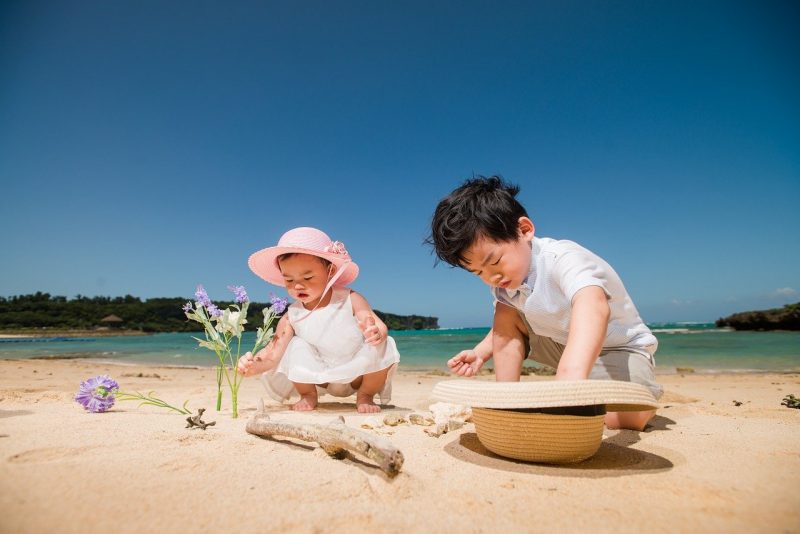
While infant swimsuits are cute, they aren’t the coolest option. They are tight against the skin, which can actually make babies hotter in certain areas.
Instead, opt for loose clothing. If your little one will be exposed to the sunlight, loose clothing that covers the arms and legs can also help protect them from sunburn. Cotton is the best fabric to select. It is breathable and known for being cooler than other fabrics.
Morning Or Afternoon
Typically, the hottest part of the day is from 11-3. This is the time that your newborn at the beach is more likely to overheat.
Instead of heading down to the beach when the temperature is at it’s hottest, opt for early morning or late afternoon trips for those cuddle sessions on the sand. This alone will help keep your baby cooler.
Battery Operated Fan
My grandson was hot and fussy in the car and on walks in his stroller. So, we picked up a battery-operated fan. It has legs that bend so that it can be wrapped around the car seat to stay in the perfect position.
These fans are specifically made for convenience, and they work surprisingly well for how small they are!
[amalinkspro type=”showcase” asin=”B07Q37C1YB” apilink=”https://www.amazon.com/dp/B07Q37C1YB?tag=mominformedcom-20&linkCode=osi&th=1&psc=1″ new-window=”true” addtocart=”false” nofollow=”true” sc-id=”4″ imgs=”LargeImage” link-imgs=”false” specs=”【Flexible Tripod】The small fan with unique flexible tripod design. This tripod uses high quality metal and Silicone cover, you can bent any angle you want, grip it, wrap it, stand it, keep it durable, flexible and stable.~~~【Versatile and Portable】This Portable baby fan with flexible legs allow you to secure fan to baby stroller, car seat,crib, Keep you and your baby cool. It also can be used as a desktop air fan or handheld fan.~~~【USB or Battery Powered】2 in 1 powered style, support USB or Battery powered. 3~8 hours working time depends on speed, 1pc 2600mA rechargeable battery is included. 3.5 hours for full recharge. (Can also be charged by computer, laptop , power bank, car charger etc).~~~” btn-color=”#ff9900″ btn-text=”Buy on Amazon” alignment=”aligncenter” hide-prime=”0″ hide-image=”0″ hide-reviews=”0″ hide-price=”0″ hide-button=”0″ width=”750″]WiHoo Mini Stroller Fan[/amalinkspro]
Other Important Safety Tips To Remember
While these are the primary safety concerns that you will need to keep in mind when taking an infant to the beach, there are a few other things to consider while you’re there to make sure that your baby stays safe.
- Avoid open water as it can have fish that bite or sting, such as jellyfish
- Don’t dunk your little one in the water. Some believe that this can help them learn to swim later, but it can also result in them getting water in their lungs, which can be dangerous.
- Watch out for sharp rocks. If you have a little one that is walking on the beach, be careful near the water where there usually tends to be more rocks.
- Teaching toddlers how to jump over waves is a great idea if you live near the beach, and plan on going a lot. As children get older and you head out a little further with them, they can jump up if there’s a big wave coming to keep their head above water.
- Avoid strong currents. If you do take your baby in the water, make sure to avoid strong currents or large waves. These make it more likely that you will fall or accidentally drop your baby in the water, both of which can be extremely dangerous.
What To Pack When Taking A Baby To The Beach
When you take your baby anywhere, that’s going to involve some packing, but the beach will require a few additional things to make sure that the day goes smoothly.
View in gallery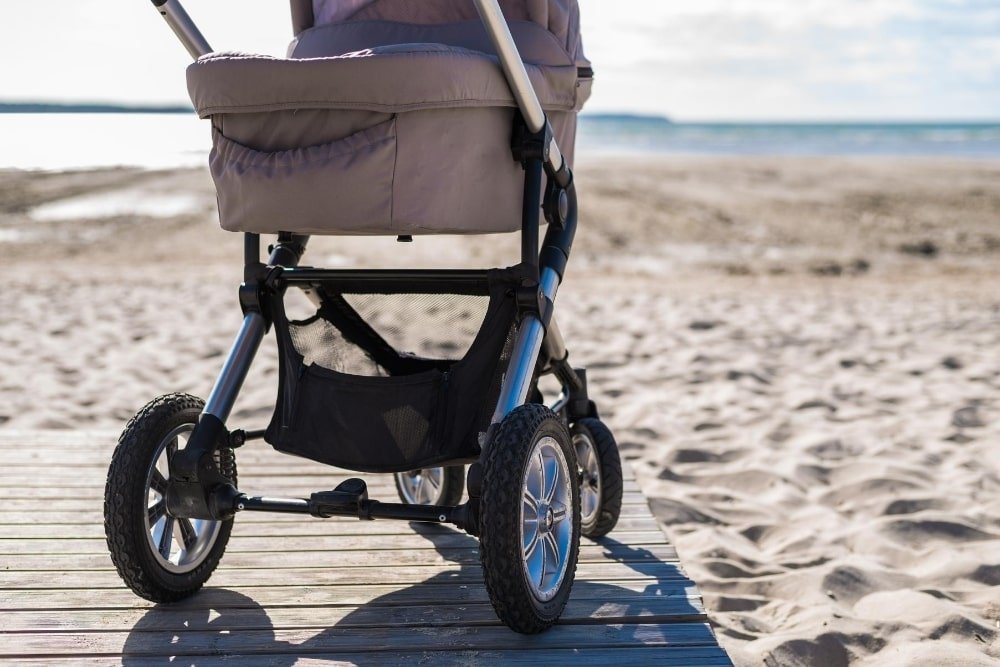
This baby beach packing list will give you everything you need in addition to what you would normally pack:
- sunscreen
- sunglasses
- blankets (to sit on, lay on, or put your little one on)
- battery operated fan
- extra water
- snacks if applicable
- beach toys if they are old enough to play with them
- beach tent
- waterproof diaper
- hats
The above list is rather general, so it’s essential to make your own age-specific list depending on your baby. A newborn that is not going in the water will not need a majority of the things on the list, for example.
A thin receiving blanket over a portion of their car seat can provide shade, and they are too young to need a waterproof diaper, snacks, or beach toys. Hats are still both effective and adorable at this age, however. So are sunglasses.
There is no specific age to answer the question when can I take my baby to the beach? Instead, it’s important to bring proper baby gear and take precautions that are appropriate for your little one.
Your infant can head to the golden sands nearby as soon as you are ready to take them!


